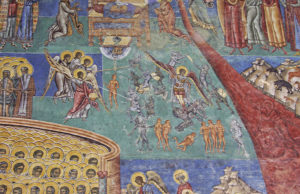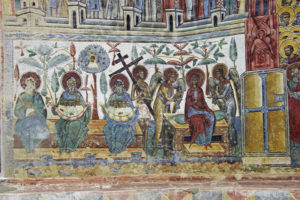Voronet was one of the first monasteries to be built by Stephen the Great in 1488 in celebration of his victory at the battle of Vaslui. According to the legend, Stephen the Great visited Daniel a local hermit renowned for his piety and wisdom, to ask his advice. The hermit advised Stephen to continue fighting and foretold of his victory. After winning the battle, Stephen kept his promise to Daniel and built a church dedicated to St George. There is a commemorative inscription above the original doorway in the exonathex.
The frescoes date from 1547-50 and feature an intense shade of blue known as Voronet Blue which was made from lapis lazuli. The church was extended in the C16th, when the porch was enclosed.
The monastery is set at the base of the hillside at the end of the village which is set in a narrow valley. The road leading to the monastery is lined with stalls selling handicrafts, including hand embroidered blouses and children’s clothes.
The monastery was originally surrounded by a defensive wall although part of this, along with the monastic buildings is now ruined. The gateway tower is the only tower to survive.
The church is the typical triconch design and was originally built with chancel, naos and pronaos. There as no burial chamber and the exonarthex was added later.
The apses have the Prayer of all the Saints, although the lower frescoes, particularly on the north side have weathered badly. At the top in round medallions are figures of archangels. The small niches have seraphs with folded wings. Below are he prophets, apostles and martyrs at the bottom.
Most of the south wall is taken up by the Tree of Jesse. At the bottom is Christ rising from the dead. The six pagan philosophers are on the pillar to the right of the Tree, not underneath as normally shown.
Also on the south wall, to the left of the door is a fresco of Stephen with Daniel the Hermit.
The frescoes on the north wall are very faded and weathered. They include the Akathistos Hymn, more usually found on the south wall with the Tree of Jesse. Below it are scenes from the life of St Anthony.
The west wall is covered by a fresco of the Last Judgement. At the top is God the Father. On either side of Him are rolling up the carpet of time with the signs of the Zodiac signifying the passing of time. Below is Christ sitting in judgement. From his feet springs the red river of HellHe is surrounded by the twelve apostles with Mary and John the Baptist. On either side are angels. Below Christ is the throne of the second coming with Adam and Eve kneeling on either side. On the right, Moses is leading the damned to face trial. From their dress they include Jews, Turks, Tatars, Armenians and Arabs.
Below Moses, and to the right of the red river of hell, angels are blowing the last trump and the dead are rising out of their graves. The bodies of the damned can be seen falling down the red river to be met by Satan sitting on a two headed monster.
Below the throne of the second coming is the hand of God holding the scales for weighing souls. Angels with long lances are fighting black devils that want to tip the scales in their favour.
Below this is a scene representing the death of the righteous and the sinner. At the top left, Lazarus is on his death bed being comforted by an angel and King david playing a lute. Below on the right is a greedy rich man with devils waiting for his soul.
On the left of the Last judgement are the righteous (prophets, bishops martyrs and hermits) with St Paul on their way to paradise. Here, the Virgin flanked by two angels, the three patriarchs of the church, Abraham, Isaac and Jacob along with the robber crucified with Christ are waiting to welcome them.
There is a small charge to visit and a photo permit for the outside of the building is 10 Lei.
There are more pictures “here.”:http://wasleys.org.uk/eleanor/otherholidays/romania/day_six/six_four/index.html
We visited as part of a ten day trip to Romania. My full report and all my pictures are “here.”:http://wasleys.org.uk/eleanor/otherholidays/romania/index.html









